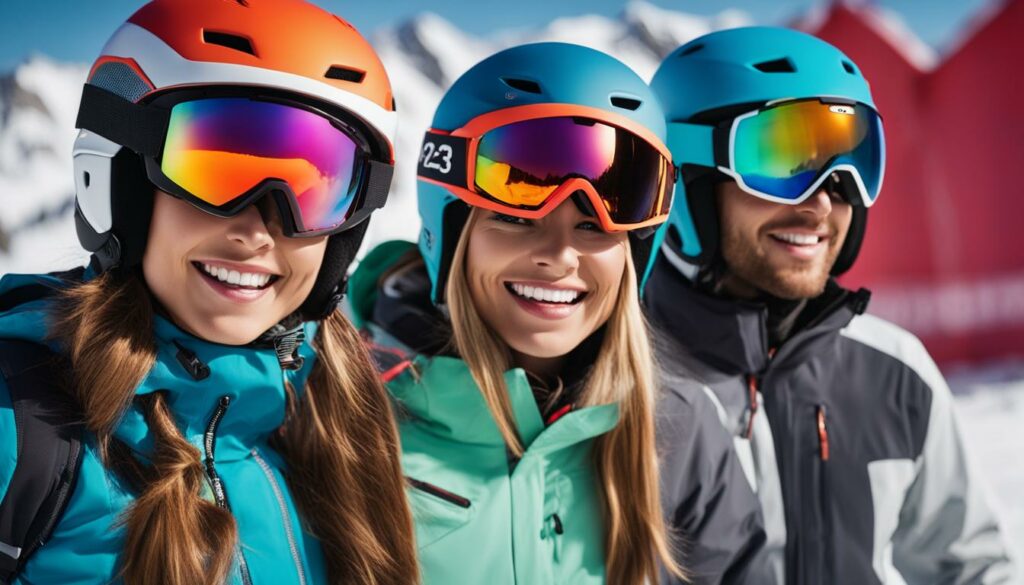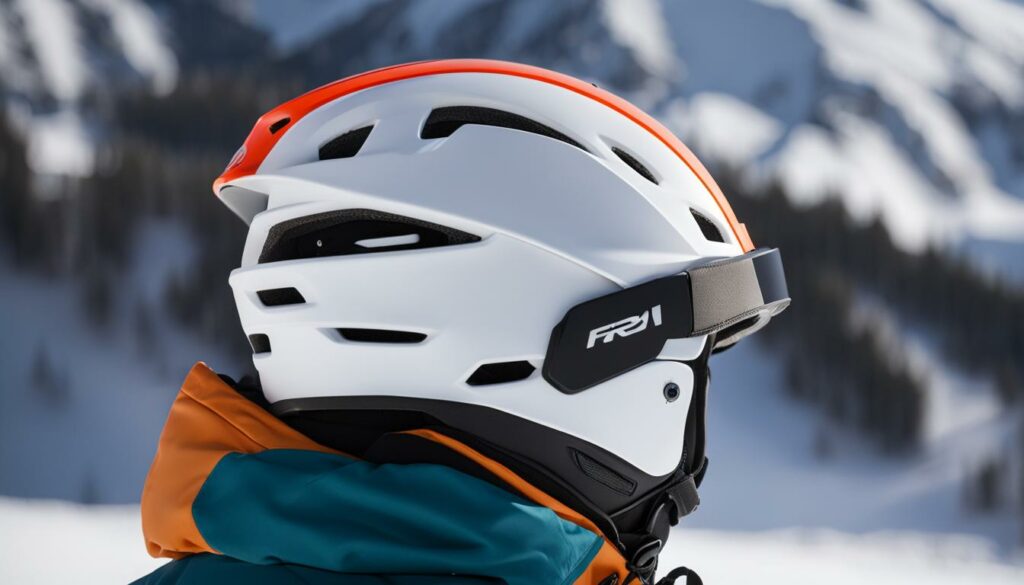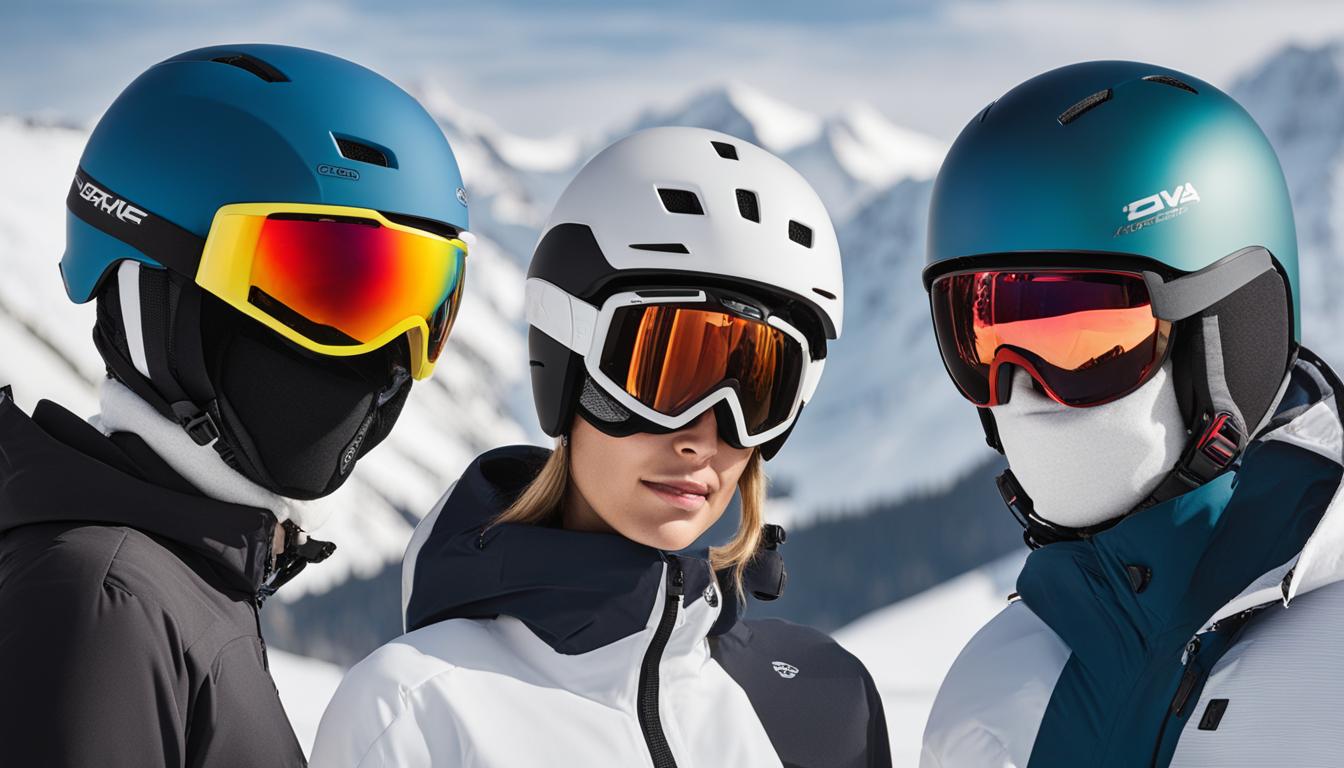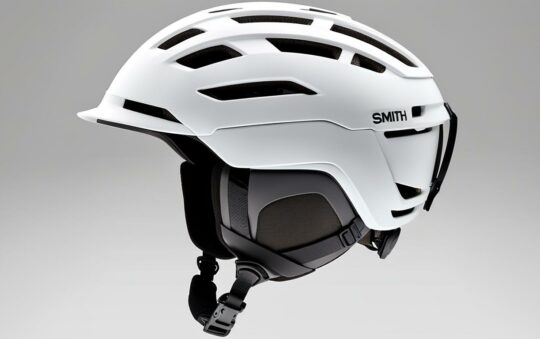When it comes to skiing, safety should always be a top priority. One essential piece of equipment that every skier should invest in is a high-quality skiing helmet. Ski helmets not only protect against head injuries but also provide peace of mind for skiers hitting the slopes. In this article, we will explore the importance of skiing helmets and provide a comprehensive list of the best ski helmets for 2023.
Key Takeaways:
- Investing in a high-quality skiing helmet is crucial for ensuring safety on the slopes.
- Ski helmets not only protect against head injuries but also provide peace of mind for skiers.
- We have compiled a list of the best ski helmets for 2023 to help you make an informed decision.
- Stay tuned to learn about the features, benefits, and design advancements of these top-rated ski helmets.
- Remember, prioritizing safety while skiing is essential for a enjoyable and worry-free experience.
Why Ski Helmets Are Essential for Safety
Skiing is an exhilarating sport that offers thrills and excitement, but it also comes with potential risks. One of the most crucial safety measures skiers should take is wearing a ski helmet. Head injuries can be severe and even life-threatening, making the use of ski helmets essential for protecting oneself on the slopes.
Without a helmet, skiers are exposed to the dangers of head trauma, concussions, and other serious injuries. The impact from a fall or collision can result in severe damage to the head and brain. However, by wearing a ski helmet, skiers greatly reduce the risk of such injuries.
Ski helmets provide impact protection by absorbing and distributing the force of a blow to the head, thereby reducing the risk of skull fractures and brain injuries. They act as a necessary barrier between the head and external elements, cushioning the impact and preventing direct contact with hard surfaces.
In addition to impact protection, ski helmets offer further benefits in terms of head injury prevention. The padding inside the helmet helps to minimize the risk of concussions by absorbing and dissipating the forces generated during a fall or collision. This can significantly reduce the severity of head injuries and improve overall safety for skiers.
Overall, wearing a ski helmet enhances safety on the slopes and is a proactive measure to prevent head injuries. The combination of impact protection and head injury prevention makes ski helmets indispensable for any skier, regardless of skill level or experience.
Top Picks for Best Skiing Helmets 2023
When it comes to skiing, safety should always be a priority. Investing in a high-quality ski helmet is essential to protect yourself from potential head injuries on the slopes. To help you make an informed decision, we’ve compiled a list of the top-rated skiing helmets for 2023. These helmets have been carefully selected based on their comfort, style, advanced protection features, and versatility.
Smith Vantage MIPS: A Blend of Comfort, Style, and Advanced Protection
The Smith Vantage MIPS helmet is a perfect blend of comfort, style, and advanced protection. It features a Multi-directional Impact Protection System (MIPS) that reduces rotational forces during an impact, providing an added layer of safety. With its lightweight construction and adjustable ventilation system, the Smith Vantage MIPS ensures optimal comfort and breathability. Its sleek design and customizable fit make it a popular choice among skiers of all levels.
Giro Ratio MIPS: Affordable Without Compromising on Safety
For those looking for an affordable yet safe option, the Giro Ratio MIPS helmet is an excellent choice. Equipped with the MIPS technology, it offers advanced protection against rotational forces. The Giro Ratio MIPS is engineered to provide optimal impact protection while maintaining a lightweight design. Its adjustable fit system ensures a secure and comfortable fit, while the integrated ventilation system keeps you cool on the slopes.
Smith Mission MIPS: The Versatile Choice for Resort and Backcountry
The Smith Mission MIPS helmet is designed to be versatile, making it suitable for both resort skiing and backcountry adventures. It features the MIPS technology, providing superior protection against rotational forces. The helmet’s AirEvac ventilation system helps regulate temperature during intense activity, while its lightweight construction ensures maximum comfort. With its stylish design and adjustable fit system, the Smith Mission MIPS helmet offers a perfect balance between performance and style.
Whether you’re a seasoned skier or a beginner hitting the slopes for the first time, these top picks for the best skiing helmets in 2023 are sure to meet your safety needs. Don’t compromise on safety – choose a helmet that offers the right combination of comfort, style, and advanced protection to make your skiing experience both safe and enjoyable.

MIPS and Rotational Impact Protection Explained
In the realm of helmet safety features, MIPS technology has emerged as a game-changer. MIPS stands for Multi-directional Impact Protection System, and it is designed to provide rotational impact protection, which is crucial in reducing the risk of head injuries, including concussions.
Traditional helmets are primarily focused on linear impact protection, meaning they are designed to absorb and mitigate the energy from direct, linear impacts. However, in many real-life scenarios, head injuries occur due to rotational forces. These forces cause the brain to twist and shear inside the skull, resulting in potential damage.
This is where MIPS technology comes into play. The MIPS system is a layer inside the helmet that allows for multidirectional movement between the outer shell and the liner. In the event of an angled impact, the MIPS layer absorbs the rotational forces by allowing the helmet to slide slightly, mimicking the brain’s natural protective layers.
By decreasing the rotational forces transmitted to the brain, MIPS technology significantly reduces the risk of concussions and other head injuries. It is particularly effective in scenarios where impacts occur at an angle, such as in the case of falls or collisions during skiing or snowboarding.
The inclusion of MIPS technology in ski helmets is a notable advancement in helmet safety. It provides an extra layer of protection that traditional helmets lack, making it a valuable feature for those looking to prioritize safety. When choosing a ski helmet, considering one with MIPS technology is crucial for ensuring optimal head protection on the slopes.

Key Features to Look for in the Best Skiing Helmets
When it comes to choosing a skiing helmet, there are several important features to consider. These features not only enhance your skiing experience but also ensure your safety on the slopes. In this section, we will discuss three key features that should be on your radar when buying a ski helmet: ventilation systems, finding the right fit, and managing comfort and style through weight and design.
Ventilation Systems: Balancing Warmth and Breathability
A well-designed ventilation system is essential for maintaining optimal comfort while skiing. It helps regulate temperature inside the helmet, balancing warmth and breathability. Look for helmets with adjustable vents that allow you to control the airflow. This feature is particularly important during strenuous activities or warm weather conditions when you need increased airflow to prevent overheating. A well-ventilated helmet will keep you cool, dry, and comfortable throughout your skiing sessions.
The Importance of Finding the Right Fit
One of the most crucial aspects of a ski helmet is the proper fit. A helmet that fits correctly provides optimal protection and comfort. When choosing a helmet, consider the circumference and shape of your head. Try on different sizes and models to find the one that offers a secure and snug fit without any pressure points. Most helmets feature adjustable straps and fit systems that allow you to customize the fit to your head shape. Remember, a well-fitting helmet should sit low on your forehead, covering the entire head and ensuring maximum safety.
Weight and Design: Managing Comfort and Style
The weight and design of a ski helmet can significantly impact your comfort and style while skiing. A lightweight helmet will be less burdensome on your head and neck, allowing for a more enjoyable experience. Look for helmets made with advanced materials that provide durability without adding unnecessary weight. Additionally, pay attention to the design aesthetic of the helmet, ensuring it aligns with your personal style. Whether you prefer a sleek and minimalist look or vibrant colors and patterns, choose a helmet that represents your individuality while prioritizing safety.

Maintaining Your Ski Helmet for Longevity
Proper maintenance and care of your ski helmet are essential for prolonging its lifespan and ensuring optimal performance. Follow these tips and guidelines to keep your helmet in excellent condition:
- Cleaning: Regularly clean your helmet to remove dirt, sweat, and debris. Use a mild soap or helmet-specific cleaner and a soft cloth or sponge. Avoid abrasive cleaners or scrubbing too hard, as they can damage the helmet’s surface. Rinse thoroughly and allow it to air dry.
- Storage: Store your helmet in a cool, dry place away from direct sunlight and extreme temperatures. Avoid placing heavy objects on top of the helmet, which can cause deformation. Consider using a helmet bag or case for added protection during transportation.
- Inspection: Regularly inspect your helmet for any signs of wear or damage. Check for cracks, dents, or loose parts. Pay attention to the strap and buckle system to ensure they are functioning properly. If you notice any issues, it may be time to replace your helmet.
- Replacement: Replace your ski helmet if it has been involved in a significant impact or after a certain period of time, typically every 3-5 years, depending on the manufacturer’s recommendations. Even if there are no visible signs of damage, the helmet’s protective capabilities may have been compromised.
By following these ski helmet maintenance and care tips, you can ensure the longevity of your helmet and continue to ski with confidence, knowing that you’re well protected.
Ensuring Proper Fit with Goggles for Optimal Safety
When it comes to skiing safety, the proper fit between ski helmets and goggles plays a crucial role. Using ill-fitting or incompatible goggles with helmets can introduce potential risks and compromise overall safety on the slopes. To ensure optimal safety, it is important to select goggles that are compatible with different helmet designs and achieve a secure and comfortable fit.
Here are some tips and guidelines to help you find the right combination of ski helmet and goggle:
- Check for Compatibility: Before purchasing goggles, make sure to check if they are compatible with your ski helmet. Some helmet brands offer goggles specifically designed to fit their helmet models, ensuring a seamless integration.
- Consider Helmet Design: Different helmet designs have varying shapes and sizes. Take into account the specific design of your helmet when choosing goggles to ensure a proper fit.
- Adjustable Straps: Look for goggles with adjustable straps that can be comfortably secured to your helmet. This will help achieve a snug fit while also accommodating any size adjustments.
- Try Them On Together: To ensure a proper fit, try on your ski helmet and goggles together before hitting the slopes. Adjust the straps and position the goggles to ensure they sit securely on your face and provide unobstructed vision.
Remember, the combination of a well-fitting ski helmet and properly matched goggles is essential for optimal safety and protection. Don’t compromise on fit when it comes to these important pieces of safety equipment.

The Evolution of Ski Helmet Designs Over the Years
In recent decades, the evolution of ski helmet designs has been significant, driven by advancements in technology, materials, and a growing focus on safety. From humble beginnings to today’s highly engineered headgear, ski helmets have come a long way. Let’s explore the historical perspective of their development.
Early ski helmets were primarily made of leather, offering minimal protection against impacts. However, as skiing gained popularity and safety concerns arose, manufacturers began experimenting with innovative designs and materials.
One milestone in ski helmet evolution was the introduction of the hardshell construction in the 1960s. With a hard outer shell and an inner foam layer, these helmets provided improved impact absorption and durability. This breakthrough set the stage for further advancements in helmet design.
A significant leap came in the 1990s with the integration of MIPS (Multi-directional Impact Protection System) technology. MIPS revolutionized helmet safety by addressing rotational forces that can cause brain injuries. By allowing the helmet to rotate slightly upon impact, MIPS helps reduce the risk of traumatic head injuries.
Another area of development in ski helmet design is aerodynamics and ventilation. Helmet manufacturers have incorporated streamlined shapes and adjustable ventilation systems to enhance airflow and regulate temperature, providing skiers with optimal comfort throughout their adventures on the slopes.
Modern ski helmets also prioritize lightweight construction without compromising protection. Utilizing advanced materials like carbon fiber and high-strength plastics, helmet manufacturers have achieved optimal balance between weight and safety.
In terms of aesthetic appeal, ski helmet designs have become more stylish and customizable. Skiers can now choose from a wide range of colors, finishes, and unique graphics to express their individuality on the slopes.
As technology continues to advance and safety standards evolve, we can expect further innovations in ski helmet designs. These advancements will undoubtedly enhance protection, comfort, and style, allowing skiers to enjoy their time on the slopes with confidence.
Conclusion
In conclusion, wearing a skiing helmet is of paramount importance for ensuring safety on the slopes. As discussed throughout this article, ski helmets provide vital protection against head injuries and help prevent potentially life-threatening accidents. When it comes to choosing the best skiing helmet for 2023, there are several top picks worth considering.
Among the recommended options are the Smith Vantage MIPS, which offers a perfect blend of comfort, style, and advanced protection. Another excellent choice is the Giro Ratio MIPS, known for its affordability without compromising on safety features. For those seeking versatility, the Smith Mission MIPS is an ideal option suitable for both resort and backcountry skiing.
When selecting your own skiing helmet, it’s crucial to prioritize safety above all else. Consider factors such as ventilation systems to balance warmth and breathability, finding the right fit for optimal comfort and protection, and managing weight and design to ensure a pleasant skiing experience. By maintaining your helmet properly and regularly inspecting it, you can prolong its lifespan and ensure it remains in optimal condition.
Lastly, don’t forget about the importance of pairing your ski helmet with compatible goggles for maximum safety. Ensuring a proper fit between the helmet and goggles is essential in maintaining clear vision and preventing any discomfort or hazards.
As you hit the slopes in 2023 and beyond, remember to prioritize your safety by investing in a high-quality and well-fitted skiing helmet. With the recommended top picks and the knowledge of important features to consider, you can enjoy a safe and enjoyable skiing experience.
FAQ
What is the importance of wearing a ski helmet?
Wearing a ski helmet is crucial for safety on the slopes. It helps protect against head injuries and concussions, providing impact protection and preventing head trauma. Ski helmets enhance overall safety while skiing.
Which are the top picks for the best skiing helmets in 2023?
The top picks for the best skiing helmets in 2023 include the Smith Vantage MIPS, Giro Ratio MIPS, and Smith Mission MIPS. These helmets offer a blend of comfort, style, advanced protection, and versatility.
What is MIPS and how does it work in ski helmets?
MIPS stands for Multi-directional Impact Protection System. It is a technology that provides rotational impact protection by allowing the helmet to rotate slightly upon impact. This reduces the risk of concussions and other head injuries.
What key features should I consider when choosing a skiing helmet?
When choosing a skiing helmet, it’s important to consider ventilation systems for warmth and breathability, finding the right fit for optimal safety and comfort, and managing comfort and style preferences with weight and design.
How do I maintain and take care of my ski helmet?
To ensure the longevity of your ski helmet, you should follow proper cleaning techniques, storage recommendations, and inspection guidelines. It’s also important to know when to replace a helmet and be aware of signs of wear or damage.
Why is it important to ensure a proper fit between ski helmets and goggles?
Ensuring a proper fit between ski helmets and goggles is crucial for optimal safety. Using ill-fitting or incompatible goggles with helmets can pose potential risks. It’s important to select goggles that are compatible with different helmet designs and achieve a secure and comfortable fit.
How have ski helmet designs evolved over the years?
Ski helmet designs have progressed in terms of safety features, materials, and design aesthetics. Significant advancements have contributed to the overall improvement of skiing helmets, enhancing protection and comfort for skiers.




